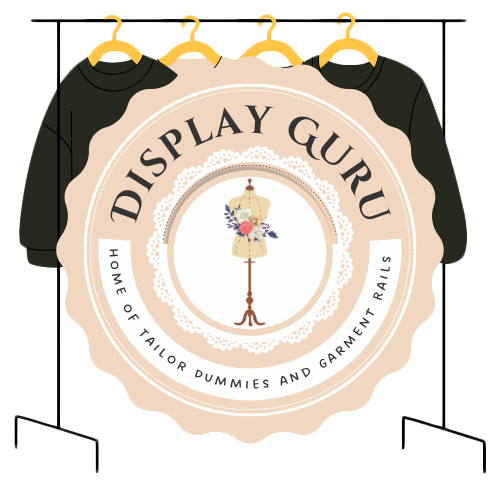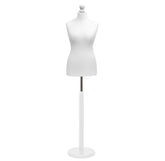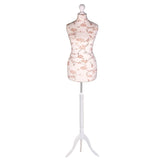A Retailer's Guide to Dummies for Clothes
A 'dummy for clothes', or what we in the industry call a mannequin, is far more than just a place to hang a shirt. Think of it as your brand's silent salesperson, a crucial visual tool that tells a story and helps customers imagine how your apparel will actually look and feel on them. Getting this choice right is fundamental to bringing your garments to life.
Why Your Choice of Mannequin Matters
Consider your mannequin the canvas for your fashion art. The right one can completely change how a customer perceives your clothing's quality, style, and value. It’s the difference between a garment looking flat and uninspired, and one that appears dynamic, desirable, and worth every penny. A well-chosen dummy for clothes shows off the fit, drape, and silhouette in a way a simple hanger never could.
The selection process really comes down to aligning the mannequin with three core elements of your business:
- Your Brand Identity: A sleek, abstract dummy might perfectly suit a modern, high-fashion brand, whereas a realistic one could be a better fit for a family-focused store.
- Your Target Customer: The dummy should echo the body type and style of your ideal shopper. This makes the clothing feel more relatable and helps the customer connect with it.
- The Clothing Itself: Different garments need different presentations. For instance, intricate garments like an Elegant Gothic Lolita ensemble might demand a specialty mannequin to truly capture the intended silhouette and volume.
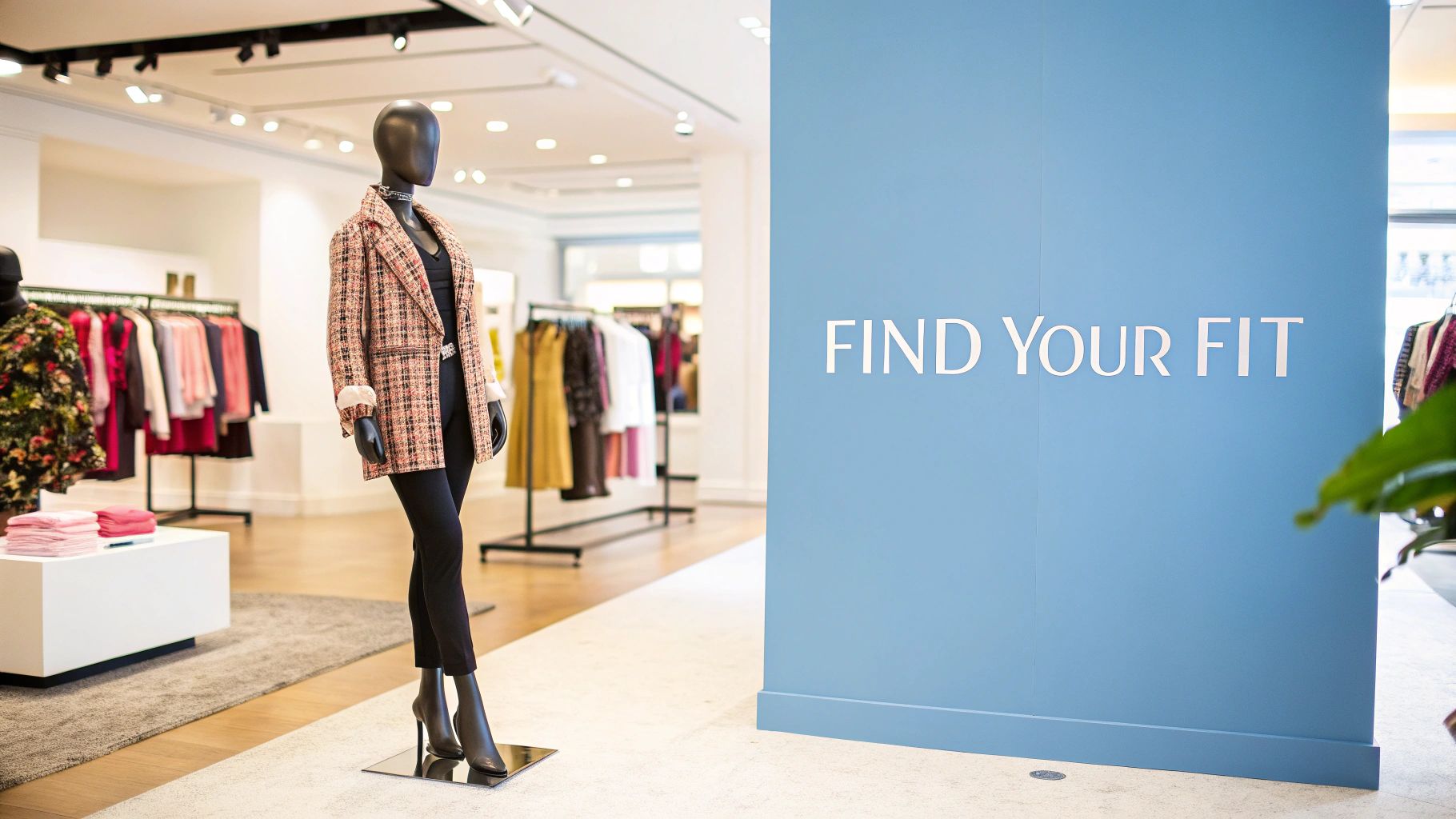
Materials and Market Trends
The UK's vibrant fashion scene has driven steady growth in the mannequin market. This has led to some fantastic innovation in both design and materials—from classic fibreglass to highly durable plastics. You can now find everything from abstract and realistic forms to simple torsos, all designed to meet different merchandising needs. This expansion means retailers have a wider choice than ever to find that perfect silent salesperson.
Key Factors for Your Selection
Choosing the right mannequin goes beyond simple aesthetics; it's a strategic decision. The material will affect its durability and cost, the pose sets a mood, and the overall style needs to click with your customers. If you're looking for practical setup tips, our guide on how to best use a mannequin on a stand is a great place to start.
A mannequin does more than just wear clothes; it communicates your brand's story and connects with your customer's aspirations. Choosing the right one is an investment in your store's visual language and, ultimately, its sales performance.
To help frame your thinking, let's break down the key considerations. This table gives a quick summary to guide you through the essentials.
Quick Selection Guide for Clothing Dummies
A summary of key factors to consider when choosing a dummy for your clothes, helping you match the right type to your brand's specific needs.
| Consideration | Why It Matters | Example Application |
|---|---|---|
| Material | Affects durability, weight, and price. Fibreglass is classic, while plastic is often more robust and affordable. | A high-traffic retail floor might benefit from a durable plastic dummy that can withstand knocks and bumps. |
| Style (Realistic vs. Abstract) | The style sets the tone. Realistic mannequins are relatable, while abstract ones feel more artistic and high-end. | An avant-garde fashion boutique might use abstract, headless mannequins to focus attention solely on the garment's design. |
| Pose (Static vs. Dynamic) | The pose creates a mood and suggests movement. A dynamic pose is great for sportswear; a static one is better for formalwear. | A sports shop displaying running gear would use mannequins in active poses to convey energy and performance. |
Ultimately, the goal is to find a mannequin that not only looks good but also works hard for your brand, helping to turn window shoppers into loyal customers.
Exploring Different Types of Mannequins
Not all clothing dummies are created equal. Far from it. Think of them as different actors, each cast for a specific role in your shop's story. Understanding their unique strengths is the key to picking the perfect model to showcase your apparel and really get your brand's personality across.
Diving into the world of mannequins can feel a bit overwhelming at first, but the core differences are actually quite simple. Let's break down the main categories—realistic, abstract, headless, and torso forms—to help you figure out which style is the best fit for your store's narrative.
Realistic Mannequins: The Storytellers
Realistic mannequins are the character actors of the retail world. With their detailed facial features, expressive poses, and lifelike hair, they create a relatable persona that helps shoppers connect with an outfit on a personal level. It’s much easier for a customer to picture themselves wearing the clothes when they see them on a "person".
These are the go-to choice for creating aspirational scenes in your window displays. Imagine showing how a complete look comes together for a wedding or a big holiday party. The power here is relatability—a shopper sees a person, not just a product holder.
Of course, that strong personality can sometimes be a double-edged sword. A very specific look might not resonate with all your customers, and if you're not careful with styling, the mannequin itself can sometimes overshadow the clothes.
Abstract Mannequins: The Modern Sculptures
On the complete other end of the spectrum, you have abstract mannequins. These are the modern art sculptures of your shop. They do away with all the realistic details, often favouring minimalist, stylised, or even geometric forms. Their entire purpose is to put the garment, and nothing else, in the spotlight.
This clean, minimalist approach has made them a firm favourite for high-end boutiques and designer showrooms. An abstract form allows the texture of a fabric, the precision of a cut, or the vibrancy of a colour to command full attention without any human distraction.
An abstract mannequin doesn't sell a lifestyle; it sells the design. It encourages the customer to appreciate the craftsmanship and unique qualities of the clothing itself, making it a powerful tool for brands focused on artistry.
While they ooze sophistication, they can occasionally feel a bit cold or unapproachable in a more mainstream retail setting. Their lack of relatable features means the shopper has to do a little more work to imagine the clothes on themselves.
Comparing Mannequin Types for Your Store
Choosing the right mannequin is a strategic decision that shapes how customers perceive your brand and your products. This table breaks down the most common styles to help you weigh their strengths and weaknesses for your specific needs.
| Mannequin Type | Best For | Pros | Cons |
|---|---|---|---|
| Realistic | Creating lifestyle scenes, storytelling in window displays, and high-end fashion. | Highly relatable; helps customers visualise the complete look; creates an emotional connection. | Can be expensive; a specific "look" may not appeal to all demographics; might distract from the clothing. |
| Abstract | Designer boutiques, minimalist stores, and showcasing artisanal or avant-garde fashion. | Puts 100% focus on the garment's design and quality; modern and sophisticated aesthetic. | Can feel impersonal or cold; less relatable for the average shopper. |
| Headless | High-street retail, diverse product ranges, and stores wanting a modern but accessible look. | Universal appeal; cost-effective; keeps the focus on the clothes while showing a full silhouette. | Lacks the personality and storytelling power of realistic mannequins. |
| Torso/Body Form | Displaying specific items like tops, knitwear, and accessories; small spaces and pop-ups. | Space-saving and economical; excellent for highlighting individual pieces; great for merchandising tables. | Cannot display a full outfit; limited in its display capabilities. |
Ultimately, the best choice depends on your brand identity, your target audience, and the story you want to tell. Many stores find a mix of types works best to create varied and dynamic displays.
Headless Mannequins: The Versatile Workhorses
Headless mannequins beautifully strike the balance between the realistic and the abstract. By removing the head, you get rid of specific facial features and expressions, giving them a universal appeal that connects with a much broader audience. This neutrality makes them incredibly versatile.
These clothing dummies are a staple for high-street stores because they are just so practical and efficient. They keep the focus firmly on the clothing's fit and form while still giving you that complete human silhouette, from neck to feet.
Here’s why they’re so popular:
- Wider Appeal: Without a defined persona, a diverse range of customers can easily project themselves onto the display.
- Cost-Effective: They are often more affordable than their highly detailed realistic cousins.
- Focus on Fashion: The eye is naturally drawn down to the torso and legs, right where the main garments are.
As brands rightly place more importance on inclusivity, these forms offer a straightforward solution. The conversation around diverse representation is vital, and you can learn more about how to incorporate stylish and inclusive store displays with different body shapes.
Torso Forms: The Specialists
Finally, we have torso forms, sometimes known as body forms. Think of these as the specialists, designed to highlight specific items rather than entire outfits. Whether as countertop busts or full torsos on a stand, they are perfect for showcasing T-shirts, jumpers, necklaces, or scarves.
Their compact size makes them brilliant for smaller shops, pop-up events, or for creating focused displays within a larger store. They're also a classic tool for tailors and seamstresses who need to check fits and make adjustments. While they can't show a full head-to-toe look, for focused, space-saving utility, they are absolutely unmatched.
How to Select the Perfect Dummy for Your Brand
Once you understand the different styles out there, the real work begins: choosing a clothing dummy that’s a perfect match for your brand’s personality. This isn't just about picking a prop; it’s about asking the right questions to make sure your mannequin becomes a powerful brand ambassador.
Think of it like you're casting the lead role in your brand’s story. Is your aesthetic edgy and modern, classic and refined, or clean and minimalist? The answer to that question will point you towards a mannequin that tells your brand's story before a customer even lays a hand on a garment.
Aligning with Your Target Customer
Next, you need to think long and hard about who you're selling to. A mannequin should be a mirror for your target customer, helping them to literally see themselves in your clothes. This means getting specific about the body shapes, poses, and general vibe that will connect with your audience.
Inclusivity isn’t just a buzzword anymore; it’s a non-negotiable part of modern retail. Bringing plus-size or gender-neutral mannequins into your displays sends a clear message that your brand is welcoming and real. When customers see that kind of diversity reflected in your shop, it builds a genuine connection and fosters loyalty.
This is an area where retailers are making some seriously smart moves. Mannequins, or dummies for clothes, are a huge part of the UK's visual merchandising industry, directly shaping how shoppers feel and what they buy. We're seeing some real innovation in the market, with manufacturers creating gender-neutral and size-inclusive mannequins to better reflect the world we live in. This trend, along with new tech like 3D printing, shows just how much the industry is evolving.
Choosing the Right Material
The material your dummy is made from is like the canvas for your art—it affects both the final look and how long it will last. For years, traditional fibreglass has been the industry go-to, known for its smooth finish and for being surprisingly lightweight. It gives off a classic, premium feel that works brilliantly in many high-end retail spaces.
But the conversation around sustainability has opened up some fantastic new possibilities. Many brands are now choosing mannequins made from recyclable plastics or other eco-friendly materials. This lets you weigh up what's most important and make a choice that truly reflects your brand's values.
When you're deciding, keep these key factors in mind:
- Durability: Is the dummy going to be in a high-traffic area where it might get bumped? Tough, hard-wearing plastics can often take more of a beating than fibreglass.
- Aesthetics: Does the finish of the material fit with your shop's décor and overall brand image?
- Cost: Your budget will obviously play a part, but try to see this as a long-term investment in your shop’s visual appeal.
- Brand Values: Opting for a sustainable material can be a powerful, visible way to show your brand's commitment to being environmentally responsible.
This decision tree can help simplify things by linking the type of clothing you sell to the ideal dummy style.
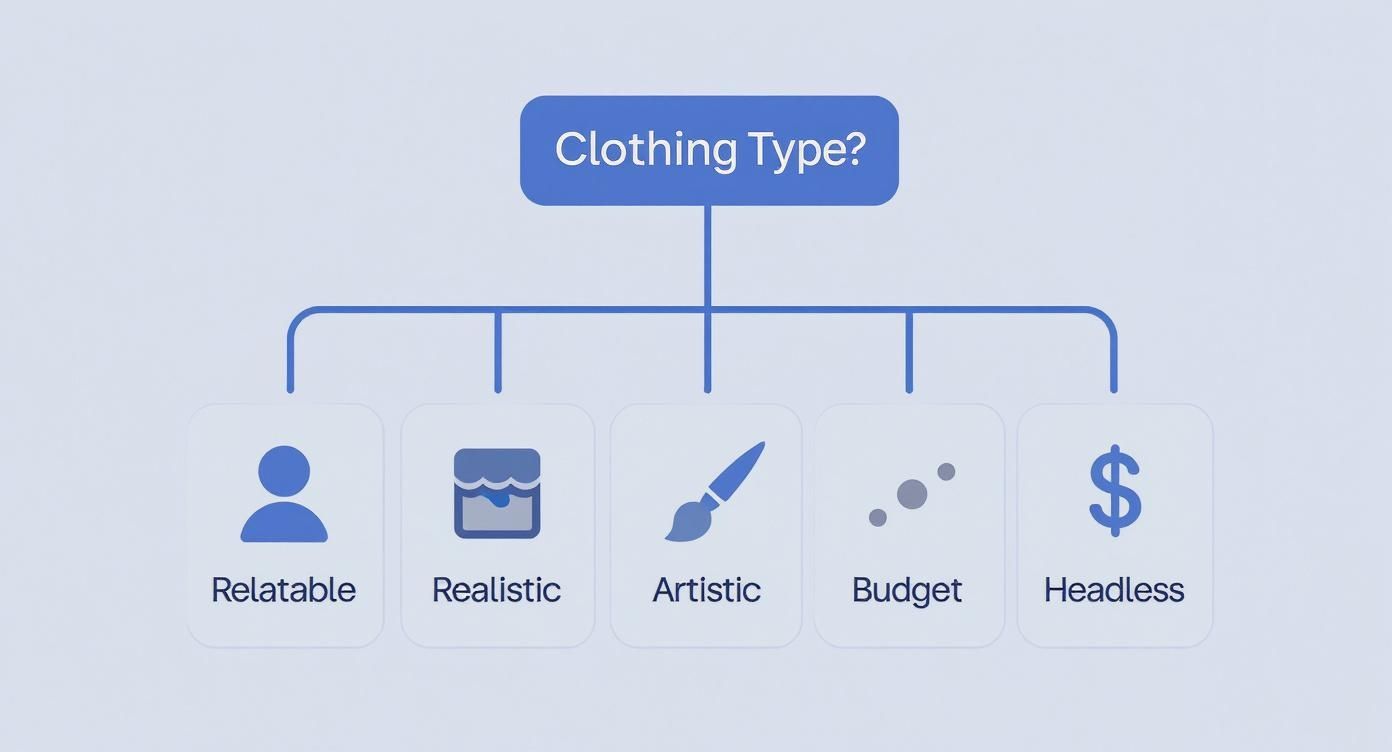
This handy visual guide shows how different goals—whether you're aiming for relatability, artistry, or sticking to a budget—point you directly to specific types of mannequins, making the selection process that much easier.
Creating a Cohesive Visual Strategy
At the end of the day, your choice of dummy has to be a considered part of your wider visual merchandising strategy. It needs to work hand-in-hand with your store's lighting, layout, and overall atmosphere to create a shopping experience that feels cohesive and inviting. A well-chosen dummy does so much more than just hold clothes; it holds up and strengthens your entire brand identity.
The perfect dummy doesn't just display a product; it embodies your brand's personality and makes a direct, unspoken connection with your ideal customer. It’s a silent storyteller that can turn a browser into a buyer.
By carefully thinking through your brand, your customer, and your material options, you can pick a mannequin that truly works for you. To take this a step further, have a look at our guide on essential visual merchandising guidelines to make sure every single element in your store is telling the same powerful story.
Assembling and Styling Your Clothing Dummy
So, you've just unboxed your new clothing dummy. That's the easy part. The real magic happens when you bring it to life, a process that’s part technician, part stylist. It all starts with a solid assembly to create a stable foundation and ends with styling that makes your clothes tell a story.
Think of putting the dummy together as setting the stage for a performance. Every piece, from the base and stand to the torso and limbs, needs to fit together perfectly. If you rush this bit, you risk a wobbly display or, worse, damaging the dummy or your garments.
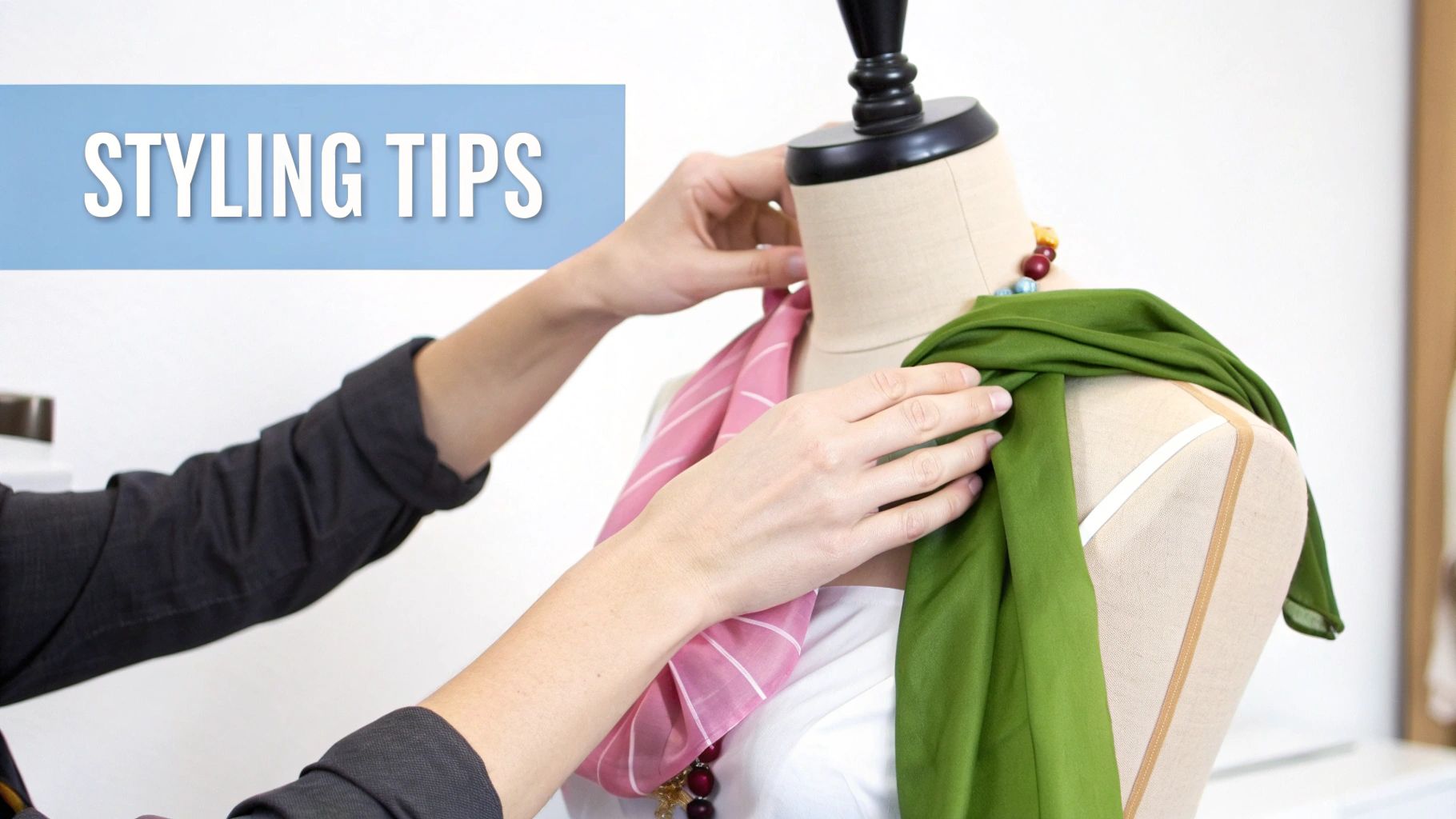
Setting Up for Success
Before you even think about dressing your dummy, make sure it’s built properly and standing in the right spot. A stable, well-placed mannequin looks far more professional and is safer for everyone.
Get these first steps right, and you're golden:
- Follow the Instructions: I know, it's tempting to just jump in, but every model has its own quirks. Take five minutes to read the guide. You'll thank yourself later when you're not forcing joints that don't want to connect.
- Get the Base Right: The stand is your anchor. Check that every screw is tight and the dummy is perfectly balanced, especially if you're planning on a more dynamic pose that shifts its centre of gravity.
- Position for Impact: Pop your assembled dummy in a well-lit area where it can be seen from all sides. Think about the flow of foot traffic in your shop and place it right where it will catch a customer's eye.
Once the physical form is ready, the fun part begins. This is where you switch hats from assembler to visual storyteller.
The Art of Styling Your Dummy
Styling isn't just about throwing some clothes on a form. It's about creating a look that speaks directly to your ideal customer. You want shoppers to see the outfit and immediately picture themselves in it. This comes down to the details—from how a collar lies to the perfect accessory.
A well-styled dummy does more than just show off an outfit; it sells an idea. It turns a piece of clothing into an aspirational look, helping customers see its true potential.
To get that professional finish, a few techniques are essential. Pinning is your best friend for getting the fit just right, particularly if a garment is a touch too big for the form. Use small, discreet pins along the back seams to pull the fabric taut, creating a sharp, tailored silhouette that looks absolutely flawless from the front.
Techniques for a Polished Look
Creating a display that genuinely wows involves a few key practices that turn your dummies from static props into your best salespeople. Getting these right can completely change how your merchandise is perceived. For a more detailed walkthrough, our guide on how to dress a mannequin like a pro is packed with expert tips.
- Strategic Layering: Layering creates depth and visual interest. A plain T-shirt instantly looks better under an open shirt, which looks even more put-together with a jacket on top. You're not just showing more products; you're showing customers how to style them.
- Thoughtful Accessorising: Accessories are what complete the story. A simple scarf, a well-placed handbag, or the right piece of jewellery adds a pop of colour and context, turning a basic outfit into something special.
- Dynamic Posing: If your mannequin has adjustable arms and legs, use them! A slight bend in the elbow or a leg angled outwards brings a sense of movement and energy to the display. It's far more engaging than a stiff, lifeless pose and is guaranteed to capture more attention.
Maintaining Your Mannequins for Longevity
Your dummies for clothes are a huge business asset; think of them as your silent salespeople, working tirelessly day in and day out. Like any valuable tool, they need proper care to keep them looking their best and doing their job effectively. A consistent maintenance routine is the secret to protecting your investment and getting the most out of their lifespan.
It’s a bit like the upkeep you’d do on a classic car—a little effort goes a very long way in preserving its value and appeal. Scuffs, dust, and chips can make even the most incredible garments look tired and unloved. A pristine mannequin, on the other hand, makes sure your clothing always looks sharp and catches the shopper's eye.

Routine Cleaning and Care
The simplest way to keep your mannequins looking sharp is through regular cleaning. In a busy shop, dust and fingerprints can build up surprisingly fast, dulling the finish and making your displays look neglected. All it takes is a simple, consistent schedule to stay on top of it.
For day-to-day upkeep, just follow these straightforward steps:
- Dust Regularly: Give the entire surface a gentle wipe-down with a microfibre cloth or a soft-bristled brush at least once a week.
- Wipe Away Smudges: For fingerprints and other minor marks, a slightly damp cloth usually does the trick. Just be sure to wipe away any leftover moisture with a dry cloth straight away.
- Address Spills Quickly: If anything gets spilt on your dummy, clean it up immediately to prevent staining, especially on lighter-coloured models.
Handling Different Materials
Not all mannequins are created equal, and the material they’re made from will determine the best way to clean them. Using the wrong products can cause irreversible damage, such as scratching a glossy finish or causing discolouration.
When cleaning your clothing dummies, always start with the gentlest method first. Harsh chemicals are rarely needed and often do more harm than good, permanently damaging the very surface you're trying to protect.
Here’s a quick guide on how to safely clean the two most common materials:
- Fibreglass Mannequins: These are often painted, making them sensitive to anything abrasive. For tougher spots, use a soft cloth with a tiny amount of mild soap and water. Never, ever use scouring pads or chemical solvents.
- Plastic Mannequins: While plastic is more durable, it can still scratch. A non-abrasive cleaner or a simple soap-and-water solution is perfect. If the finish is textured, a soft brush can help get dirt out of any little crevices.
Safe Handling and Storage
How you handle your mannequins is just as crucial as how you clean them. Most damage, like chips and cracks, happens when they’re being moved or stored incorrectly. When you need to reposition a dummy, always lift it by its sturdiest points—like the waist or torso—and never by the arms or hands, which can easily snap off.
When it's time to put your mannequins away, perhaps during a seasonal display change, taking a few extra minutes to store them properly will save you a fortune in replacements.
Seasonal Storage Checklist:
- Disassemble Carefully: Take the mannequin apart, separating the arms, hands, legs, and torso to prevent putting stress on the joints.
- Wrap Each Piece: Use bubble wrap or soft cloths to wrap each component individually. This is your best defence against scratches and impact damage.
- Label Everything: Pop the wrapped pieces into sturdy boxes and label them clearly. It’ll make reassembly much faster and less of a headache.
- Store in a Safe Place: Keep the boxes in a dry, climate-controlled spot away from direct sunlight, which can cause warping or fading over time.
Innovations in Mannequin Technology and Design
The humble clothing dummy is in the middle of a quiet but powerful revolution. For decades, it’s been a static prop, but that’s all changing. Thanks to some exciting advances in tech, a serious push for sustainability, and new ways of making things, the mannequin is becoming a dynamic, interactive tool that’s reshaping retail.
What was once just a simple form for showing off an outfit is now becoming a much smarter, more engaging part of the shop floor.
The Rise of Smart Mannequins
Imagine a mannequin that does more than just stand there looking good. ‘Smart’ mannequins are now appearing, kitted out with technology to gather useful insights and draw customers in. These aren't just dummies for clothes; they’re becoming active players in the shopping experience.
For instance, some new models have sensors that can anonymously track customer engagement—things like how many people stop to look at a display and for how long. Others might have tiny, built-in digital screens showing product details, styling tips, or the latest promotions.
One of the most interesting developments isn't a physical mannequin at all, but shares the same goal: virtual clothing try-on apps. This tech helps customers see what an outfit would look like on them without ever stepping into a changing room. You can discover more about virtual clothing try-on apps to get a sense of where this is all heading. It’s a major shift from passive displays to active engagement.
Sustainability and Eco-Friendly Materials
The fashion industry’s growing conscience is also having a big impact on mannequin design. For years, fibreglass was the go-to material, but its environmental footprint has sent manufacturers looking for greener options. This search has led to a new generation of materials.
The focus is shifting towards a circular economy. Mannequins made from recycled plastics, bio-resins, and even sugarcane derivatives are becoming more common, offering a durable and eco-friendly choice for conscientious brands.
This sustainable mindset isn't just about the materials, either. Manufacturers are now designing mannequins to be easily recycled at the end of their life. This ensures these essential retail tools are part of a more responsible industry. Brands that choose these eco-friendly models are also making a clear statement about their values, which is something modern shoppers really care about.
The Impact of 3D Printing
Perhaps the biggest game-changer is 3D printing. This technology has thrown the doors wide open for customisation, freeing brands from the one-size-fits-all approach of mass-produced forms. Now, a company can design a completely bespoke dummy that perfectly matches a specific campaign, collection, or customer profile.
This move towards personalisation is part of a bigger picture. The global mannequin market was valued at around USD 5.4 billion in 2024, and it's expected to climb to USD 6.9 billion by 2033. The UK retail sector is a big part of this growth, with custom body shapes and sustainable materials really driving things forward.
This technology also makes it easier to create more inclusive and realistic body shapes, including the kinds of adjustable dressmakers dummies used for bespoke tailoring. It’s all about creating something that truly represents the brand and its customers.
Got Questions? We've Got Answers
Stepping into the world of visual merchandising, you're bound to have a few questions. I've pulled together some of the most common queries I hear from retailers about using and looking after their clothing dummies. The right answers can help you make smarter decisions, create stunning displays, and ultimately protect your investment.
How Often Should I Change Outfits on My Dummies?
To keep your shop floor looking fresh and inviting, a good rule of thumb is to change your dummies' outfits at least every two weeks. This rhythm keeps things dynamic, shows off your latest stock, and gives regulars a reason to pop back in to see what's new.
Of course, that's just a baseline. For those prime spots—like your main window display or any high-traffic areas—you'll want to ramp it up. During peak seasons or for special promotions, a weekly change can make a massive difference. You want that key retail space working its hardest to grab attention and pull people in.
What Is the Best Way to Store Mannequins?
Proper storage is the secret to keeping your dummies in top shape when they're not on the shop floor. A little care goes a long way, and it all comes down to careful disassembly and protection.
Here’s a simple process to follow:
- Take it apart carefully: Separate the arms, legs, hands, and torso. Never force the joints; just follow the way they were designed to come apart.
- Wrap every single piece: Use bubble wrap or even old, soft cloths. The goal is to stop the parts from knocking against each other and causing scratches or chips.
- Box them up securely: Find sturdy boxes that fit the parts snugly without squashing them. It's a great idea to label the boxes so you know what's where later on.
- Find a safe spot: Store the boxes somewhere dry and out of direct sunlight. Big swings in temperature or damp conditions can warp plastic and ruin the finish.
Think of it like packing away delicate glassware after a party. Each piece needs its own wrapping to make sure it comes out looking just as good the next time you need it. This simple habit prevents costly damage and keeps your dummies looking pristine for years.
Are Expensive Mannequins a Worthwhile Investment?
It’s true that a premium clothing dummy comes with a higher price tag, but it's often one of the smartest long-term investments you can make for your brand. Think of it less as a cost and more as an asset.
Higher-end models are simply built to last. They use better materials and construction techniques, so they can handle the daily hustle of a busy shop without showing wear and tear. Beyond just durability, their refined look and sophisticated finish can subtly elevate the perceived value of your clothes. When a customer sees a garment on a beautifully crafted dummy, it just looks more desirable. In the long run, that powerful visual impact makes a premium mannequin a very shrewd investment.
For all your display needs, from professional tailor’s dummies to robust garment rails, explore the collection at Display Guru. Find the perfect tools to showcase your apparel at https://www.displayguru.co.uk.
